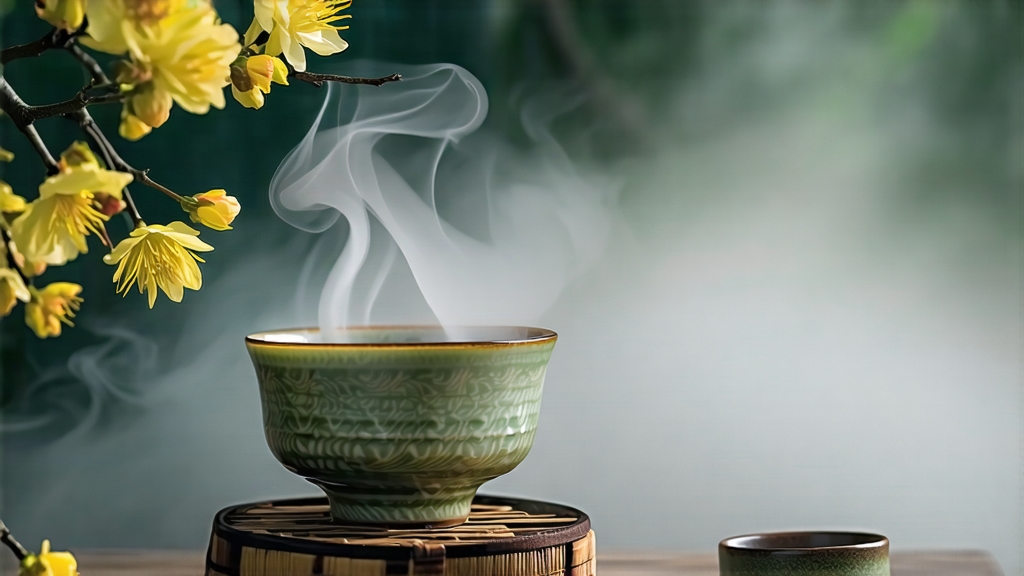
Meng Ding Huang Ya, literally “the yellow bud from Meng Summit,” is the least exported yet most aristocratic member of China’s micro-category of yellow tea. It is produced on the uppermost ridges of Mt. Meng, a granite massif that rises abruptly above the Sichuan Basin and has been famous since the Tang dynasty (618-907 CE) for teas reserved for the emperor. While green teas from the same mountain were already listed in the 803 CE “Chronicle of Famous Waters and Teas,” the deliberate yellowing technique that gives this bud tea its mellow sweetness was perfected during the early Ming, when court demand shifted from compressed bricks to loose, elegant buds. For three centuries the entire output—never more than 300 kg a year—was carried by fast horses to Beijing within fourteen days of picking, wrapped in bamboo-leaf and silk to preserve its barely oxidized, golden-green color. When the Qing court fell in 1911 the craft almost vanished; only five families on the mountain still remember the full protocol, and today genuine Meng Ding Huang Ya is limited to roughly one tonne per spring, most of which is pre-sold to collectors in Chengdu and Shanghai.
The tea belongs to the “bud-yellow” style, the smallest of yellow tea’s three sub-styles (bud-yellow, leaf-yellow, and large-leaf yellow). Picking begins in the last week of March when the plateau mornings are still 8 °C and the mountain is wrapped in cloud. Only the unopened spear, still covered in pale down and no longer than 2.5 cm, is taken; the standard is 70 000 buds per kilogram of finished tea. Because the mountain straddles the 30th parallel, ultraviolet intensity is high, prompting the plant to accumulate an unusual ratio of theanine to catechins, a chemical signature that later translates into a honey-like viscosity without grassy astringency.
The craft is summarized locally as “three greens, three yellows,” a mnemonic that describes the color journey of the leaf. First green: the fresh bud is brilliant jade when it reaches the workshop. Initial kill-green is done on a Meng-style Kou-kou wok, diameter 64 cm, heated to 140 °C by lychee wood. The master’s wrist motion—three scoops, two presses, one toss—lasts exactly 95 seconds; this deactivates polyphenol oxidase while leaving 8–10 % residual moisture, slightly more than for green tea. While still hot the buds are wrapped in two layers: an inner jacket of parchment-thin rice paper and an outer roll of steamed bamboo skin. The bundle, no thicker than a forearm, is placed in a cedar box and left for 70 minutes; this is the “sealed yellowing,” the hallmark of yellow tea. During this hold the chlorophyll degrades to pheophytin and amino acids condense into pyrroles, shifting the leaf color to the second yellow. The bundle is then opened and the buds given a second, gentler roasting at 80 °C to drive moisture down to 20 %. A second wrapping and second yellowing of 60 minutes follows, creating the third yellow. The final firing is done at 60 °C with charcoal embers covered in ash, reducing water to 5 % and locking in the chestnut-sweet aroma. From picking to finished tea the process spans 36 hours without interruption; any delay oxidizes the bud into a flat green tea, destroying the apricot-gold liquor that connoisseurs expect.
Because the leaf is so young and the yellowing so delicate, brewing must respect three constants: low temperature, tall glass, and vertical infusion. The recommended vessel is a 250 ml cylindrical glass 12 cm high; the height allows the buds to sink, stand upright, and slowly release trapped amino acids. Water should be drawn from a source with 30–50 ppm TDS; in Sichuan locals use snow-melt from the mountain’s west face. Heat to 80 °C, then cool to 75 °C by pouring once between two pitchers; this second transfer aerates the water and lowers dissolved oxygen, softening texture. Use 3 g of tea (roughly 60 buds) for 250 ml. Awaken the buds with a 15 ml “crystal rinse” at 70 °C, discarded immediately. First infusion: 75 °C, 30 seconds; the